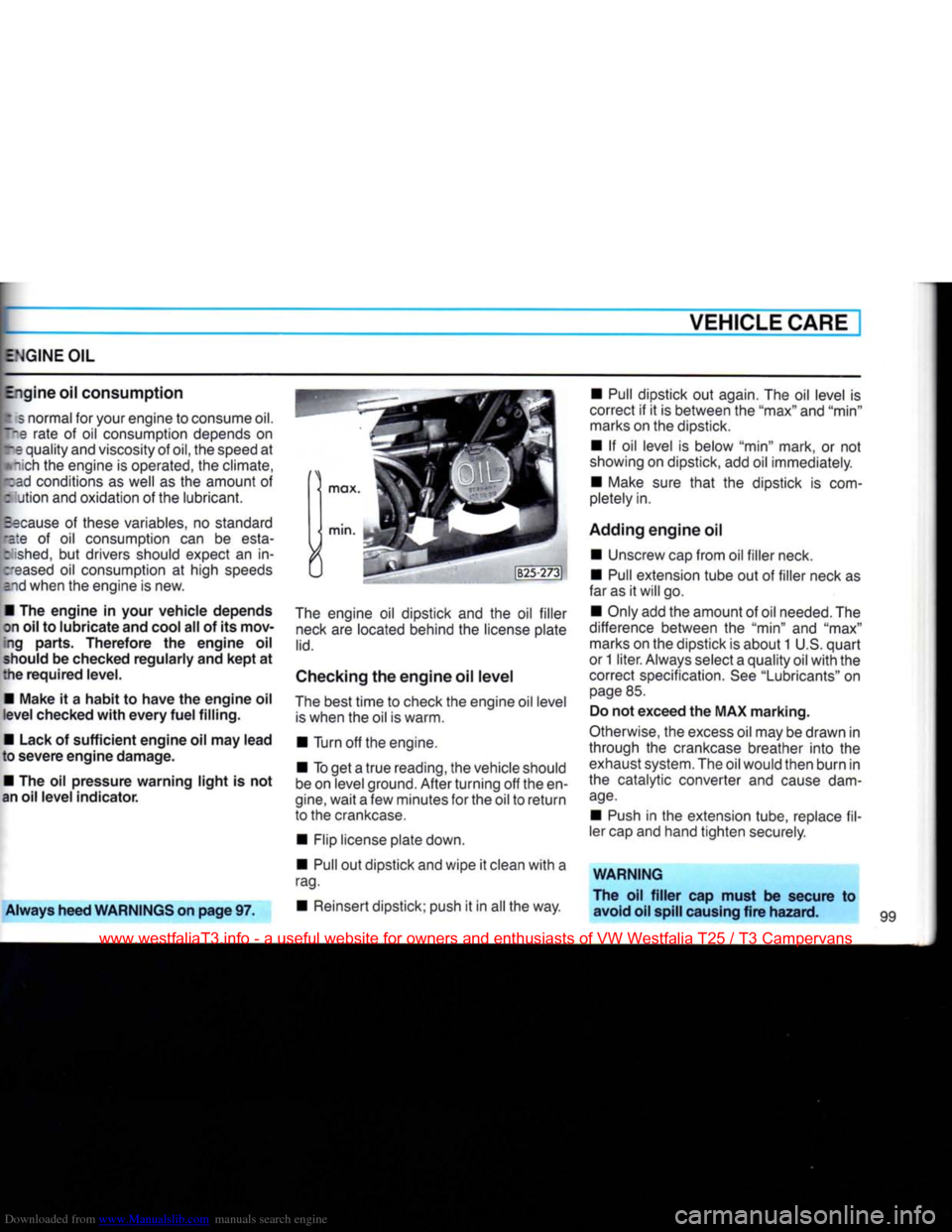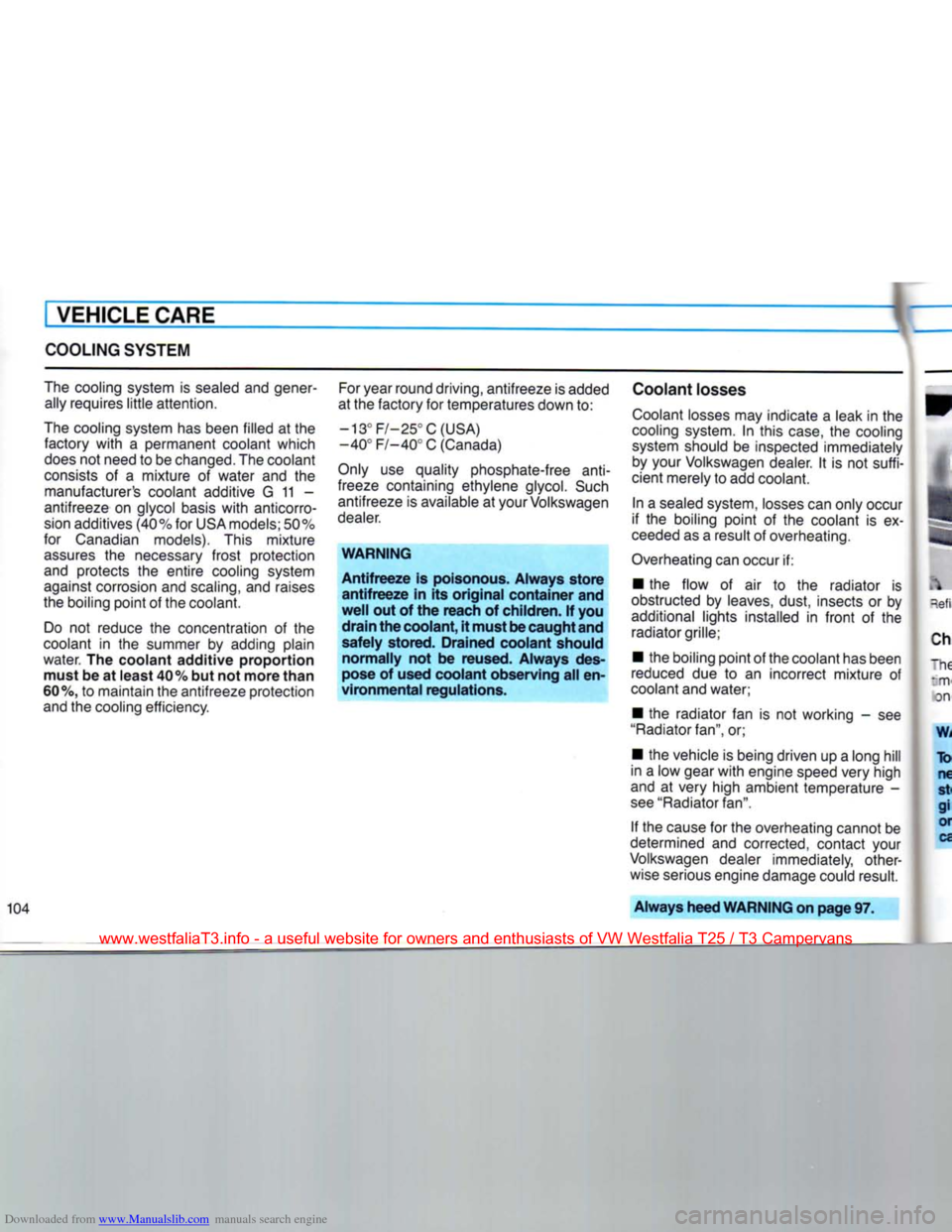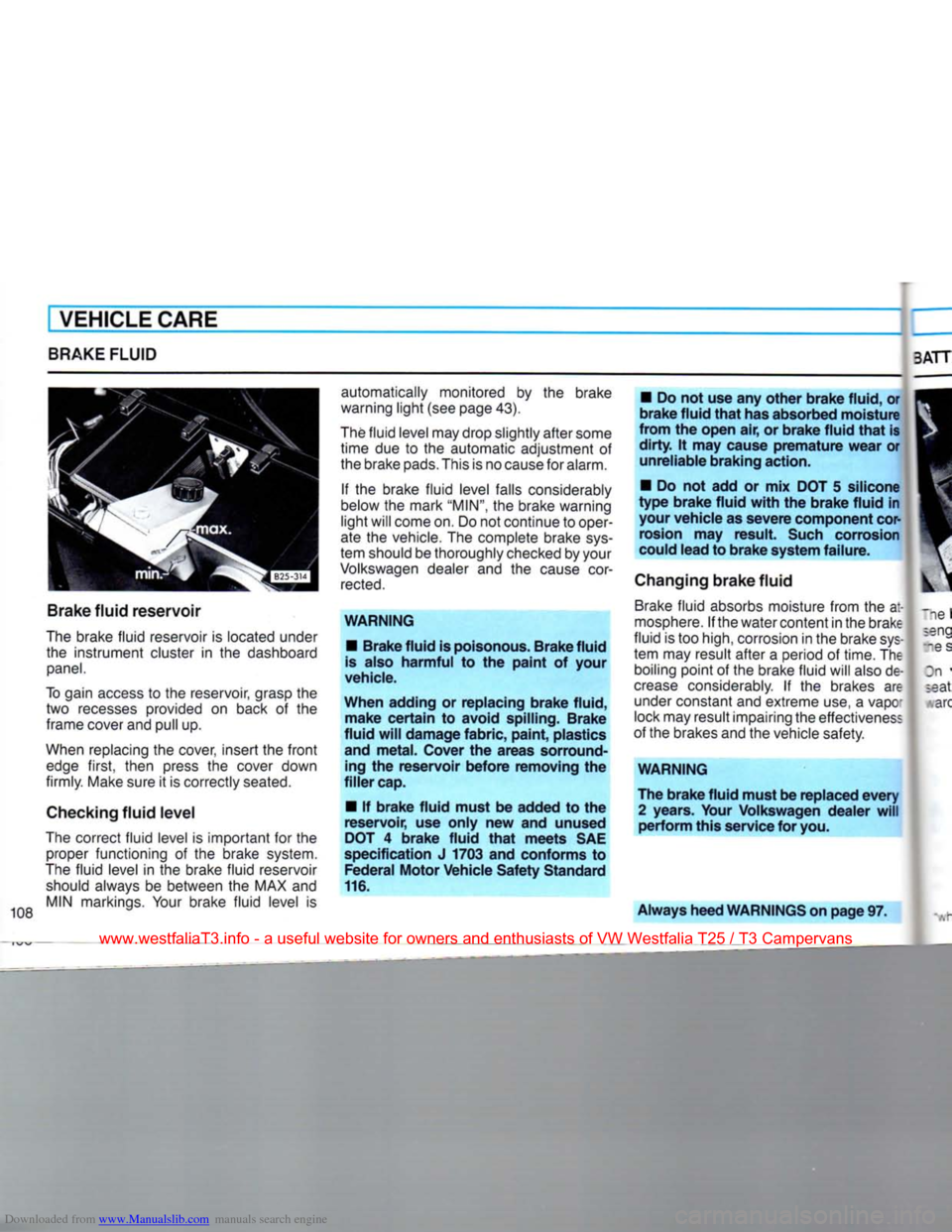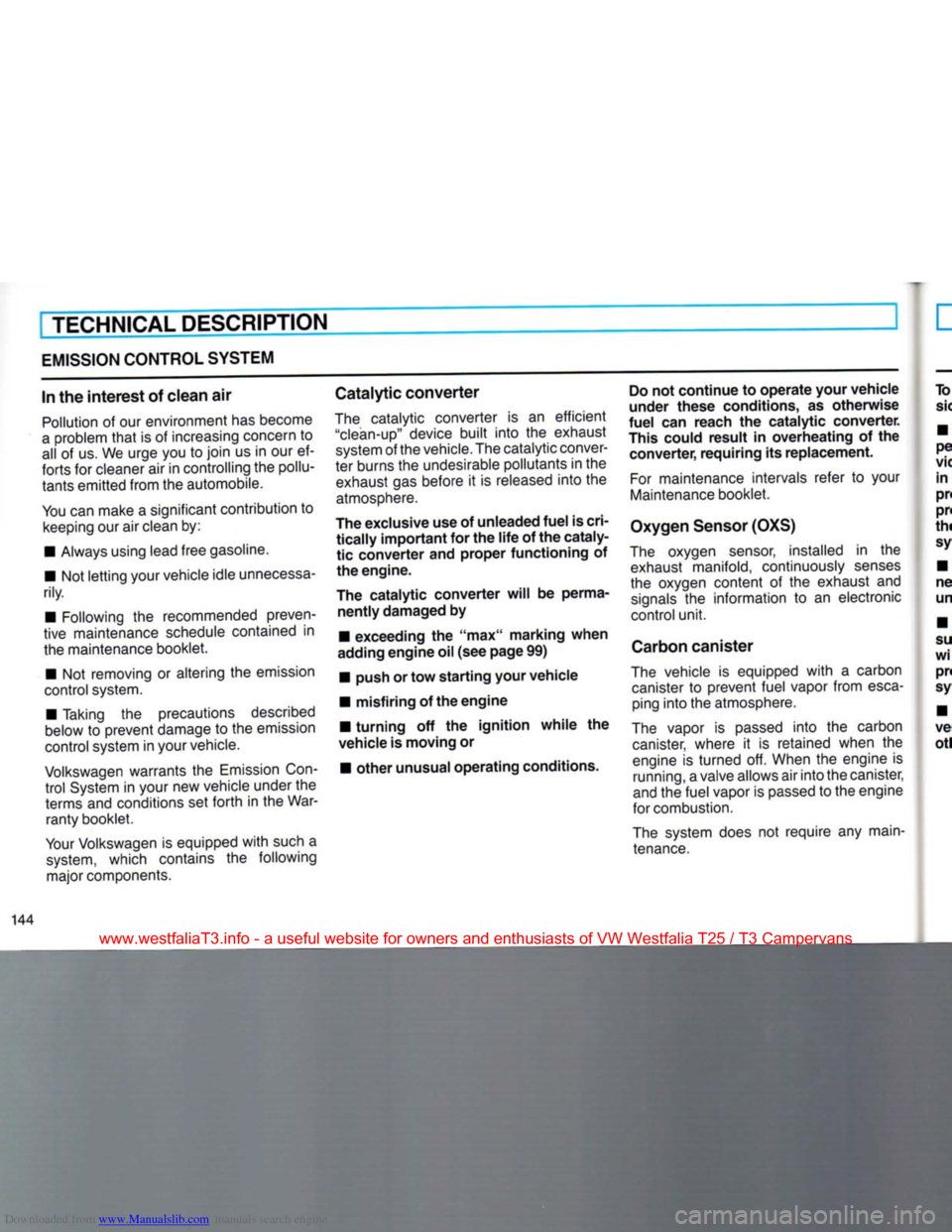1990 VOLKSWAGEN TRANSPORTER adding oil
[x] Cancel search: adding oilPage 104 of 165

Downloaded from www.Manualslib.com manuals search engine
VEHICLE CARE
ENGINE OIL
Engine oil consumption t 3 normal for your engine to consume oil.
T-Q
rate of oil consumption depends on
re quality and viscosity of
oil,
the speed at
Mich
the engine is operated, the climate,
read
conditions as well as the amount of : ution and oxidation of the lubricant.
Because
of these variables, no standard
•e:e
of oil consumption can be esta-
:
shed,
but drivers should expect an in
creased
oil consumption at high speeds
s.nd when the engine is new.
• The
engine
in your
vehicle
depends
on oil to
lubricate
and cool all of its
mov
ing
parts.
Therefore
the
engine
oil
should be checked
regularly
and
kept
at
the
required
level.
•
Make
it a
habit
to
have
the
engine
oil
level
checked
with
every
fuel
filling.
• Lack of
sufficient
engine
oil may
lead
to
severe
engine
damage.
• The oil pressure
warning
light
is not
an oil
level
indicator.
Always
heed
WARNINGS
on
page
97.
The
engine oil dipstick and the oil filler
neck
are located behind the license plate
lid.
Checking the
engine
oil
level
The
best time to check the engine oil level
is
when the oil is warm.
• Turn off the engine.
• To get a true reading, the vehicle should
be
on level ground. After turning off the en
gine,
wait a few minutes for the oil to return
to the crankcase.
• Flip license plate down.
• Pull out dipstick and wipe it clean
with
a
rag.
• Reinsert dipstick; push it in all the way. • Pull dipstick out again. The oil level is
correct if it is between the "max" and "min" marks on the dipstick.
• If oil level is below "min" mark, or not
showing on dipstick, add oil immediately.
• Make sure
that
the dipstick is com
pletely in.
Adding
engine
oil • Unscrew cap from oil filler neck.
• Pull extension tube out of filler neck as
far as it will go.
• Only add the amount of oil needed. The
difference between the "min" and "max" marks on the dipstick is about
1
U.S. quart
or
1
liter. Always select a quality oil
with
the
correct specification. See "Lubricants" on
page
85.
Do not exceed the MAX
marking.
Otherwise,
the excess oil may be drawn in
through the crankcase breather into the exhaust system. The oil would then burn in
the catalytic converter and cause dam
age.
•
Push
in the extension tube, replace fil
ler cap and hand tighten securely.
WARNING
The oil
filler
cap
must
be secure to avoid oil spill causing
fire
hazard.
www.westfaliaT3.info - a useful website for owners and enthusiasts of VW Westfalia T25 / T3 Campervans
Page 109 of 165

Downloaded from www.Manualslib.com manuals search engine
VEHICLE
CARE
COOLING
SYSTEM
The cooling system
is
sealed and gener ally requires little attention.
The cooling system has been filled at the factory with
a
permanent coolant which
does not need to be changed. The coolant
consists
of a
mixture
of
water
and the
manufacturer's coolant additive
G 11 —
antifreeze
on
glycol basis with anticorro-
sion additives (40% for USA
models;
50%
for Canadian models).
This
mixture
assures
the
necessary frost protection
and protects
the
entire cooling system
against corrosion and
scaling,
and raises
the boiling point of the coolant.
Do
not
reduce
the
concentration
of the
coolant
in the
summer
by
adding plain
water.
The coolant additive proportion
must
be at least
40%
but not more than
60%,
to
maintain the antifreeze protection
and the cooling efficiency. For year round driving, antifreeze is added
at the factory for temperatures down to:
-13°
F/-25°C(USA)
-40°
F/-40°
C
(Canada)
Only
use
quality phosphate-free
anti
freeze containing ethylene glycol. Such antifreeze
is
available at
your
Volkswagen
dealer.
WARNING Antifreeze is poisonous. Always store antifreeze in its original container and
well
out of the reach of children. If you drain
the
coolant,
it must
be
caught
and
safely stored. Drained coolant should normally not be reused. Always des-
pose
of used coolant observing all en
vironmental regulations.
Coolant losses
Coolant losses may indicate
a
leak in
the
cooling
system.
In
this
case,
the
cooling
system should
be
inspected immediately by
your
Volkswagen dealer.
It is not
suffi
cient merely to add coolant.
In a
sealed system, losses can only occur
if
the
boiling point
of the
coolant
is ex
ceeded as
a
result of overheating.
Overheating can occur
if:
•
the
flow
of air to the
radiator
is
obstructed
by
leaves, dust, insects
or by
additional
lights installed
in
front
of the
radiator grille;
•
the boiling point of the coolant has been
reduced
due to an
incorrect mixture
of
coolant and water;
•
the
radiator fan
is not
working
- see
"Radiator
fan",
or;
•
the vehicle is being driven up
a
long
hill
j
in
a
low gear with engine speed
very
high
and
at
very
high ambient temperature
-
see
"Radiator fan".
If
the cause for the overheating cannot
be
determined
and
corrected, contact
your
Volkswagen dealer immediately, other-
I
wise serious engine damage could result.
104
Always
heed
WARNING on page
97.
www.westfaliaT3.info - a useful website for owners and enthusiasts of VW Westfalia T25 / T3 Campervans
Page 113 of 165

Downloaded from www.Manualslib.com manuals search engine
VEHICLE CARE
BRAKE FLUID 3 ATT
108 Brake fluid reservoir
The brake fluid reservoir is located under the instrument cluster in the dashboard
panel.
To gain access to the reservoir, grasp the two recesses provided on back of the frame cover and pull up.
When replacing the cover, insert the front edge first, then press the cover down
firmly. Make sure it is correctly seated.
Checking fluid level
The correct fluid level is important for the proper functioning of the brake system.
The fluid level in the brake fluid reservoir should always be between the MAX and MIN markings. Your brake fluid level is automatically monitored by the brake
warning light (see page 43).
The fluid level may drop slightly after some time due to the automatic adjustment of
the brake pads. This is no cause for alarm.
If the brake fluid level falls considerably
below the mark
"MIN",
the brake warning
light will come on. Do not continue to oper
ate the vehicle. The complete brake sys
tem should be thoroughly checked by your
Volkswagen dealer and the cause cor
rected.
WARNING • Brake fluid is poisonous. Brake fluid
is also harmful to the paint of your
vehicle.
When adding or replacing brake fluid, make certain to avoid spilling. Brake
fluid will damage fabric, paint, plastics and metal. Cover the areas sorround-ing the reservoir before removing the
filler cap.
• If brake fluid must be added to the
reservoir, use only new and unused
DOT 4 brake fluid that meets SAE
specification J 1703 and conforms to Federal Motor Vehicle Safety Standard
116.
• Do not use any other brake fluid, or
brake fluid that has absorbed moisture
from the open air, or brake fluid that is
dirty. It may cause premature wear or unreliable braking action.
• Do not add or mix DOT 5 silicone
type brake fluid with the brake fluid in your vehicle as severe component corrosion may result. Such corrosion
could lead to brake system failure.
Changing brake fluid Brake fluid absorbs moisture from the at
mosphere. If the watercontent in the brake
fluid is too high, corrosion in the brake sys
tem may result after a period of time. The boiling point of the brake fluid will also de
crease considerably. If the brakes are under constant and extreme use, a vapc
lock may result impairing the effectiveness
of the brakes and the vehicle safety. -e s
Dn seat arc
WARNING
The brake fluid must be replaced every 2 years. Your Volkswagen dealer will perform this service for you.
Always heed WARNINGS on page 97.
www.westfaliaT3.info - a useful website for owners and enthusiasts of VW Westfalia T25 / T3 Campervans
Page 149 of 165

Downloaded from www.Manualslib.com manuals search engine
TECHNICAL
DESCRIPTION
EMISSION
CONTROL SYSTEM
In the
interest
of
clean
air Pollution of our environment has become
a
problem
that
is of increasing concern to
all of us. We urge you to
join
us in our ef
forts
for cleaner air in controlling the pollu
tants emitted from the automobile.
You
can make a significant contribution to
keeping our air clean by:
• Always using lead free gasoline.
• Not
letting
your vehicle idle
unnecessa
rily.
• Following the recommended preven
tive maintenance schedule contained in
the maintenance booklet.
• Not removing or altering the emission
control system.
• Taking the precautions described
below to prevent damage to the emission
control system in your vehicle.
Volkswagen
warrants the Emission
Con
trol
System in your new vehicle under the
terms and conditions set
forth
in the War ranty booklet.
Your
Volkswagen is equipped
with
such a
system,
which contains the following major components.
Catalytic
converter
The catalytic converter is an efficient
"clean-up"
device
built
into
the exhaust system of the vehicle. The catalytic conver
ter burns the undesirable pollutants in the exhaust gas before it is released
into
the
atmosphere.
The
exclusive
use of
unleaded
fuel
is cri
tically
important
for the
life
of the
cataly
tic
converter
and
proper
functioning
of
the
engine.
The
catalytic
converter
will
be
perma
nently
damaged
by
•
exceeding
the "max"
marking
when
adding
engine
oil (see
page
99)
• push or tow
starting
your
vehicle
•
misfiring
of the
engine
•
turning
off the
ignition
while
the
vehicle
is
moving
or
•
other
unusual
operating
conditions. Do not
continue
to
operate
your
vehicle
under
these
conditions, as
otherwise
fuel
can
reach
the
catalytic
converter.
This could
result
in
overheating
of the
converter,
requiring
its
replacement.
For
maintenance intervals refer to your
Maintenance booklet.
Oxygen
Sensor (OXS)
The oxygen sensor, installed in the exhaust manifold, continuously
senses
the oxygen content of the exhaust and
signals
the information to an electronic
control
unit.
Carbon
canister
The vehicle is equipped
with
a carbon canister to prevent fuel vapor from
esca
ping
into
the atmosphere.
The vapor is passed
into
the carbon canister, where it is retained when the
engine is turned off. When the engine is running, a valve allows air
into
the canister,
and the fuel vapor is passed to the engine
for combustion.
The system does not require any main
tenance.
144
www.westfaliaT3.info - a useful website for owners and enthusiasts of VW Westfalia T25 / T3 Campervans